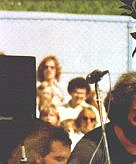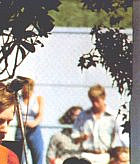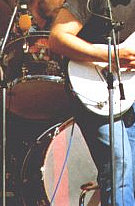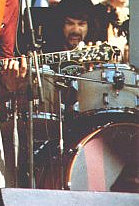|
most
people can't reach, and he can
pull them off right in
the flow of
playing. And now he's taken up playing
slide leads quite a bit, and that's neat, too, because that's another
context for me to play against. "Furthermore,
Bob has shared the vocal and songwriting chores with Garcia and generally
provided what very little on-stage communication occurs between the band
and its fiercely loyal, and still growing, legion of fans.
Born to a prominent San Francisco family, Bob was in
and out of several public and private schools owing to a rebellious nature
that was no doubt aggravated by a serious reading disability -dyslexia-
and family problems. He had no trouble with his ears, however, and
began to pick up on popular music during the early '60's folk boom. He
acquired his first guitar at 14, and by the time he met Garcia he was
ready to play in a working band. Their first collaboration, which
included Ron "Pigpen" McKernan on harmonica, was called Mother
McCree's Uptown Jug Champions. By all reports, it was a snappy and accomplished
jug band. The group was an immediate success on the local folk circuit
and played together for more than a year.
By 1965 the Beatles and Bob Dylan had helped pave
the way for the return of electric instruments in popular music, and Garcia
and Pigpen had been pressing the issue. Because Weir and other members
of the band were then working at a music store, they had access to electric
instruments and took the bait. After enlisting one of the store's
drum students, Bill Kreutzmann, and getting the son of the store owner
to play bass, they plugged in and became the Warlocks. When the work got
to be too much for the bassist, Phil Lesh was recruited to take over,
and all of the major elements locked into place. Two months later
they made it official when they adopted the name the Grateful Dead.
Soon
the band had a strong following in bars six nights a week. In 1966
novelist Ken Kesey engaged them as the house band for his Electric Kool
Aid Acid Test (which later resulted in a Bantam book of the same name
by Tom Wolfe), and the Dead learned to play in many interesting spaces.
That was also the year they began to attract the kind of fans who
would travel several thousand miles to see them play, and then camp out
in the streets in front of the theater for days to ensure a spot close
to the stage.
The
Dead signed their first recording contract and then brought on a second
drummer, Mickey Hart, in 1967. With the exception of the death of
Pigpen in 1973, a three-year hiatus by Hart between 1971 and 1974, and
the subsequent addition of Keith Godchaux and his wife Donna, the band's
lineup remained intact until 1979, when Brent Mydland became the new keyboardist.
When the Dead took a year and a half off between 1974 and 1976,
Weir became involved with an existing band, Kingfish. This alliance
lasted two years, through one studio and one live album. Weir's
first solo album, Ace, appeared in 1972. It featured the
rest of the Dead as his backup band. He had a hand in writing every
tune on the album, with most co-writing every tune on the album, with
most co-written by his boyhood friend, John Perry Barlow. Several
of the songs remain fixtures in the Dead repertoire, including "Mexicali
Blues," "Playing in the Band," and "Cassidy."
Bob's
second LP, Heaven Help the Fool, was recorded in Los Angeles and
released on Arista in 1978. The musicians were top studio players
such as David Paich and Mike Porcaro (who were to become part of Toto). Again,
the tunes were primarily Weir/Barlow collaborations. The Bob
Weir Band, featuring Bobby Cochran on lead guitar, toured briefly after
the LP was released. Weir's latest musical project [1981] is Bobby
& The Midnites, a group with Cochran, drummer Billy Cobham, and bassist
Alphonso Johnson.
Meanwhile,
the Grateful Dead roll on. Their 19th and most recent release, Reckoning.
At the time Weir was preparing material for an upcoming Bobby &
The Midnites album project and traveling between coasts doing concerts.
What
do you think is your role as a rhythm guitar player in a band?
Recently,
I've been moving my whole conception of what I should be doing as rhythm
guitarist higher and higher up the neck, just to get out of the way of
the never-ending confusion between the bass and the keyboard left hand.
I try to move into the upper registers, and once you do that, you
have a fairly well-defined sense of harmonic development. Once you
get in the upper registers, you're almost always dealing with leading
tones, Instead of roots and fundamentals. Leading tones do come
up in the bass, but not as often as in the treble register.
What
is the most challenging part of your job with the Grateful Dead?
Well,
being between Phil and Garcia, the most challenging thing is listening
to them individually and in combination and intuiting where they are heading
and what kind of chord is going to fit. I have to be there
and try to supply that tonality, and maybe even lend some sort of leading
harmonic development to it. Sometimes it works and sometimes
the magic just ain't there. But that's intuitive improvisational
music at its most challenging for me. When we're playing more structured
material, I just try to be an extension of what Phil's doing and fill
in the spaces. Sometimes I think of myself as a brass section or a string
section. When I'm on-stage playing, I'm not really conscious of
the notes and the sounds and demands of the music. And I'm trying
to most aptly supply what the music requires in terms of sounds, textures,
and harmonic development.
Does
anybody have any particular responsibility to key the changes within the
long space jams that the Dead are noted for?
What
we go for is for everybody to sort of agree "now's the time."
We try to keep it loose and open, although we have a number of musical
cues, like somebody will play a line that'll suggest, "Okay, let's
wrap it up," or "Let's head out in this direction." Sometimes
you have to play the line a number of times for people to follow it. Or
sometimes you'll play a line and somebody's got a permutation of it in
just the next bar, and then it'll be off into another realm. We do drift
from key to key and rhythm to rhythm and tempo to tempo.
It
seems as if you guys do like to play in odd time signatures.
Yeah, that's sort of been a pet
of this band for the longest time. It's fun to play in odd time
signatures. I think 7 [7/4, 7/8] is my favorite time signature.
It contains the best of 3 and the best of 4. I've gotten so
I can roll over the bar lines in 7 all day and not get lost. But
that's just a matter of practice. About 12 years ago, I got this
little device that not only has a metronome click, but also a little bell
that can be set inside it. It allows you to practice all kinds of
time signatures, but it's particularly useful for 5/4 and 7/4. I
think you can get them at percussion stores.
|





